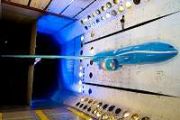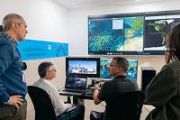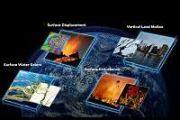
Copernical Team
In milestone, SpaceX 'catches' megarocket booster after test flight
 SpaceX on Sunday successfully flew the first-stage booster of its Starship megarocket back to the launch pad after a test flight, a technical tour de force that furthers the company's quest for rapid reusability.
The "super heavy booster" had blasted off attached to the uncrewed Starship rocket minutes earlier, then made a picture-perfect controlled return to the same pad in Texas, where a p
SpaceX on Sunday successfully flew the first-stage booster of its Starship megarocket back to the launch pad after a test flight, a technical tour de force that furthers the company's quest for rapid reusability.
The "super heavy booster" had blasted off attached to the uncrewed Starship rocket minutes earlier, then made a picture-perfect controlled return to the same pad in Texas, where a p Musk unveils robotaxi, pledges it 'before 2027'
 Elon Musk on Thursday unveiled what he said was a robotaxi capable of self-driving, predicting it would be available by 2027 - about a decade after he first promised an autonomous vehicle.
The Tesla CEO said the fully electric car - which has no steering wheel or pedals - would be priced under $30,000, would be charged wirelessly with inductive technology and would be "10 to 20 times safe
Elon Musk on Thursday unveiled what he said was a robotaxi capable of self-driving, predicting it would be available by 2027 - about a decade after he first promised an autonomous vehicle.
The Tesla CEO said the fully electric car - which has no steering wheel or pedals - would be priced under $30,000, would be charged wirelessly with inductive technology and would be "10 to 20 times safe The ZEUS Project to harness solar energy in space with nanowire technology
 The University of Malaga (UMA) is collaborating in an international consortium to advance the collection and transmission of solar energy in space through the 'ZEUS' project, part of the Horizon EIC Pathfinder Challenges. This European project, coordinated by Lund University in Sweden, has been awarded nearly euro 4 million to develop innovative nanowire solar cells designed to operate in the h
The University of Malaga (UMA) is collaborating in an international consortium to advance the collection and transmission of solar energy in space through the 'ZEUS' project, part of the Horizon EIC Pathfinder Challenges. This European project, coordinated by Lund University in Sweden, has been awarded nearly euro 4 million to develop innovative nanowire solar cells designed to operate in the h First Satellite Greenhouse Gas Plumes Identified with NASA-Designed Instrument
 Data collected by the Tanager-1 satellite, using technology designed by NASA's Jet Propulsion Laboratory (JPL), has led to the first detections of methane and carbon dioxide emissions. The nonprofit Carbon Mapper released these findings, showing methane plumes in Pakistan and Texas, and a carbon dioxide plume in South Africa.
Carbon Mapper's goal is to pinpoint greenhouse gas emissions fro
Data collected by the Tanager-1 satellite, using technology designed by NASA's Jet Propulsion Laboratory (JPL), has led to the first detections of methane and carbon dioxide emissions. The nonprofit Carbon Mapper released these findings, showing methane plumes in Pakistan and Texas, and a carbon dioxide plume in South Africa.
Carbon Mapper's goal is to pinpoint greenhouse gas emissions fro First MetOp Second-Generation Satellite Completed with Sibling Undergoing Tests
 The first MetOp Second Generation-A satellite (MetOp-SG-A1) has been fully assembled and is scheduled for launch next year, while its companion, MetOp-SG-B1, is undergoing stringent testing to ensure it can withstand the harsh conditions of space.
MetOp-SG is an advanced continuation of the original MetOp satellites, designed in three successive pairs of A-type and B-type satellites. Each
The first MetOp Second Generation-A satellite (MetOp-SG-A1) has been fully assembled and is scheduled for launch next year, while its companion, MetOp-SG-B1, is undergoing stringent testing to ensure it can withstand the harsh conditions of space.
MetOp-SG is an advanced continuation of the original MetOp satellites, designed in three successive pairs of A-type and B-type satellites. Each Parry Labs wins contract from US Space Force to modernize digital spaceports
 Parry Labs has secured a Direct to Phase II Small Business Innovation Research (SBIR) contract from the U.S. Space Force (USSF) as part of its "Digital Spaceport of the Future" challenge. This initiative focuses on enhancing spaceport operations with cutting-edge digital solutions.
Out of over 150 submitted proposals, Parry Labs was one of 12 companies chosen for this contract, issued thro
Parry Labs has secured a Direct to Phase II Small Business Innovation Research (SBIR) contract from the U.S. Space Force (USSF) as part of its "Digital Spaceport of the Future" challenge. This initiative focuses on enhancing spaceport operations with cutting-edge digital solutions.
Out of over 150 submitted proposals, Parry Labs was one of 12 companies chosen for this contract, issued thro Space-made aluminium weld analyzed at ESA lab
 ESA engineers have closely examined an aluminium weld produced in space, marking a historic achievement as the first autonomous welding conducted in orbit, and the first of its kind involving ESA. The weld, just one centimeter in size, was produced using electron beam welding during an experiment initiated by ThinkOrbital, a US startup.
This weld, created aboard a spacecraft launched via a
ESA engineers have closely examined an aluminium weld produced in space, marking a historic achievement as the first autonomous welding conducted in orbit, and the first of its kind involving ESA. The weld, just one centimeter in size, was produced using electron beam welding during an experiment initiated by ThinkOrbital, a US startup.
This weld, created aboard a spacecraft launched via a In a first, SpaceX 'catches' megarocket booster after test flight
 SpaceX successfully "caught" the first-stage booster of its Starship megarocket Sunday as it returned to the launch pad after a test flight, a world first in the company's quest for rapid reusability.
The "super heavy booster" had blasted off attached to the Starship rocket minutes earlier, then made a picture-perfect controlled return to the same pad in Texas, where a pair of huge mechanica
SpaceX successfully "caught" the first-stage booster of its Starship megarocket Sunday as it returned to the launch pad after a test flight, a world first in the company's quest for rapid reusability.
The "super heavy booster" had blasted off attached to the Starship rocket minutes earlier, then made a picture-perfect controlled return to the same pad in Texas, where a pair of huge mechanica Starship targets milestone 5th test flight with first booster recovery attempt planned
 SpaceX is gearing up for the fifth test flight of its Starship rocket, with a 30-minute launch window scheduled to open at 7 a.m. Central Time (8am ET) on Sunday, October 13. This important flight will aim to advance SpaceX's efforts toward full reusability for both the Starship vehicle and its Super Heavy booster.
A live webcast of the test will begin approximately 35 minutes before lifto
SpaceX is gearing up for the fifth test flight of its Starship rocket, with a 30-minute launch window scheduled to open at 7 a.m. Central Time (8am ET) on Sunday, October 13. This important flight will aim to advance SpaceX's efforts toward full reusability for both the Starship vehicle and its Super Heavy booster.
A live webcast of the test will begin approximately 35 minutes before lifto China successfully retrieves first reusable test satellite Shijian-19
 China has successfully retrieved its first reusable and returnable test satellite, Shijian-19, marking a significant achievement in the country's space program. According to the China National Space Administration (CNSA), the satellite was recovered at the Dongfeng landing site in Inner Mongolia at 10:39 a.m. Beijing Time on Friday.
"All the returnable payloads in fields like plant and mic
China has successfully retrieved its first reusable and returnable test satellite, Shijian-19, marking a significant achievement in the country's space program. According to the China National Space Administration (CNSA), the satellite was recovered at the Dongfeng landing site in Inner Mongolia at 10:39 a.m. Beijing Time on Friday.
"All the returnable payloads in fields like plant and mic 



































